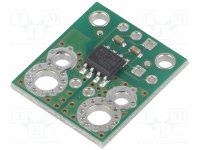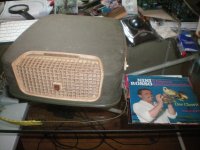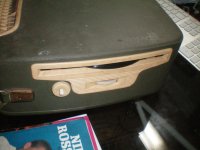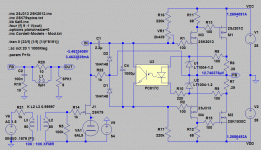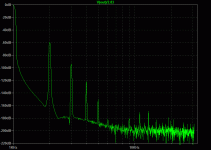no way Bubba
I asked not because I'm scared of soldering little buggers , but because I would sleep better knowing that entire amp current is not going through two tiny legs (pair plus pair) .....hoping that there is package with little less tiny legs
doesn't matter how much adapter looks nice and useful (however , nothing saving you from actually soldering little critter) , traces at adapter are too tiny for currents involved, so finally just exaggerating level of nightmares
me thinks that regular fuses are much easier to implement
I asked not because I'm scared of soldering little buggers , but because I would sleep better knowing that entire amp current is not going through two tiny legs (pair plus pair) .....hoping that there is package with little less tiny legs
doesn't matter how much adapter looks nice and useful (however , nothing saving you from actually soldering little critter) , traces at adapter are too tiny for currents involved, so finally just exaggerating level of nightmares

me thinks that regular fuses are much easier to implement

Hey, we have similar type of "tender age" dodo eyes here, we prefer the small TO264 fuses compared to the marginally visible TO92 dust spec. 😀
Found larger package ACS770/780 family for 50-200A, less resolution and spice model not found yet. Datasheet can be downloaded from here, can not attach due to forum pdf size limit. Not certain to be usable due to low resolution.
For the SOIC8, solder paste really helps as shown on youtube vid here. A bit easier, less chance for a short, the excess flux actually flows the solder to the pads. A couple of short pieces of solid copper wires can easily be added easily enough to avoid nightmares.
Found larger package ACS770/780 family for 50-200A, less resolution and spice model not found yet. Datasheet can be downloaded from here, can not attach due to forum pdf size limit. Not certain to be usable due to low resolution.
For the SOIC8, solder paste really helps as shown on youtube vid here. A bit easier, less chance for a short, the excess flux actually flows the solder to the pads. A couple of short pieces of solid copper wires can easily be added easily enough to avoid nightmares.
tnx for effort .........
looking at specs , it seems way too crude for our purpose , already found ACS723/10A being in right area for our needs
additional 1.0mm wires - already tinkered of ... and they seems mandatory
will battle with SOIC8
looking at specs , it seems way too crude for our purpose , already found ACS723/10A being in right area for our needs
additional 1.0mm wires - already tinkered of ... and they seems mandatory
will battle with SOIC8
Last edited:
How true. 😀
Only a couple of notes, as Papa said, there is a minor problem of a bit too much 2H and nice xfrmrs are spendy. Currently preparing a 10Y hybrid, still tweaking the design.
Only a couple of notes, as Papa said, there is a minor problem of a bit too much 2H and nice xfrmrs are spendy. Currently preparing a 10Y hybrid, still tweaking the design.
well
if choosing between cheap with grandiose twist and expensive with not-so-grandiose twist ............ I know where my heart is
(not counting being blessed with expensive with grandiose twist , which certainly wasn't by my choosing , just being notworthy but lucky with friends 🙂 )
if choosing between cheap with grandiose twist and expensive with not-so-grandiose twist ............ I know where my heart is
(not counting being blessed with expensive with grandiose twist , which certainly wasn't by my choosing , just being notworthy but lucky with friends 🙂 )
I did some DigiKey searches and found this one: Tamura L18P003D15. http://www.tamuracorp.com/clientuploads/pdfs/engineeringdocs/L18PXXXD15.pdf. It is not a drop in replacement for the Allegro device but might be made to work. There are some other 'Thru Hole' mounted Hall Effect sensors listed at DigiKey that might be of interest.yup
though ..... I meant to ask indra - did he found some bigger cased buggers , with same characteristics ......... 🙂
preparing one short list of special parts , to order ...... none of them being in regular stock of my usual vendors
as soon I finish that list , with ACS buggers too , I can start count 2 or 3 weeks to delivery
though , after some searching , Tamura isn't so good , considering both price and transfer characteristic ...... (checked several models )
just found some modules on TME , no solo chips
pic is good and informative ...... all I needed from this search 🙂
just found some modules on TME , no solo chips
pic is good and informative ...... all I needed from this search 🙂
Attachments
10 greenies/piece range , I would choose ALPS Board Mount Current Sensors | Mouser Slovakia
https://www.mouser.com/ds/2/15/GCBC040-1A_e-336425.pdf
however , I think I'm going to stick with first drek indra found ...... neat simple and just right
and cheap
https://www.mouser.com/ds/2/15/GCBC040-1A_e-336425.pdf
however , I think I'm going to stick with first drek indra found ...... neat simple and just right
and cheap

Surprise !!! 🙂 No battle with this Arduino current sensor module. Sensitivity is only 185mV/A though.... will battle with SOIC8
Attachments
OK - goooooooooood for experiments
but , for my use , will make my pcb arrangement , integrated on amp pcb
but , for my use , will make my pcb arrangement , integrated on amp pcb
Low voltage hybrid power gyrator assisted SE amplifier
Papa's opto bias is really crazy amazing. I'd like to share a sim of a CFP MOS output stage with an alternative no source degeneration scheme with DF ~140. When higher DF is desired, an Opto & Hall chip combo can be chosen instead.
However, it is not easy to see the merit of the circuit in LTspice. 4H and above distortion figures reported in log file are useless being buried under simulation noise floor.
The trick is to choose Hann or Blackman "windowing function" on FFT view to clean up noise floor and give more meaningful figures. At 1W, the circuit exhibit monotonic distortion spectra with 3H and higher distortion figures rivaling those of the very best conventional DHT SE tube amps, at least in simulation. The 2SK79 can be replaced by a 6DJ8 with appropriate adjustment of V9 if desired.
Papa's opto bias is really crazy amazing. I'd like to share a sim of a CFP MOS output stage with an alternative no source degeneration scheme with DF ~140. When higher DF is desired, an Opto & Hall chip combo can be chosen instead.
However, it is not easy to see the merit of the circuit in LTspice. 4H and above distortion figures reported in log file are useless being buried under simulation noise floor.
The trick is to choose Hann or Blackman "windowing function" on FFT view to clean up noise floor and give more meaningful figures. At 1W, the circuit exhibit monotonic distortion spectra with 3H and higher distortion figures rivaling those of the very best conventional DHT SE tube amps, at least in simulation. The 2SK79 can be replaced by a 6DJ8 with appropriate adjustment of V9 if desired.
Attachments
I'm tellin' ya all , all the time , that M2 is a Gem......
I made comparison sims of regular M2 and "M25" , and sent pics to Papa
I have an impression that he greened , having half glass of wine in hand , thinking ........ "who cares , I made it good enough "
having fun , while making it is , I believe , most important thing I learned from him
(most probably sole thing I was able to learn at all )
)
I made comparison sims of regular M2 and "M25" , and sent pics to Papa
I have an impression that he greened , having half glass of wine in hand , thinking ........ "who cares , I made it good enough "
having fun , while making it is , I believe , most important thing I learned from him
(most probably sole thing I was able to learn at all
 )
)- Home
- Amplifiers
- Pass Labs
- Most Greedy Boy, of them all... or (there is no) DEFiSIT of Papa's Koans

